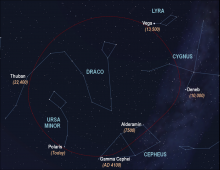Listen to today's episode of StarDate on the web the same day it airs in high-quality streaming audio without any extra ads or announcements. Choose a $8 one-month pass, or listen every day for a year for just $30.
You are here
Summer Solstice
Summer arrives in the northern hemisphere tomorrow morning. At that moment — the summer solstice — the Sun will stand farthest north for the entire year. It will stand directly overhead for skywatchers at 23-and-a-half degrees north latitude. That line is called the Tropic of Cancer, because several thousand years ago, the Sun appeared in the constellation Cancer at the solstice.
Today, though, the Sun is a long way from Cancer. Just hours after the solstice it enters Gemini, which is 30 degrees away from the crab — one-twelfth of the way across the sky.
The stars of Cancer haven’t moved much since the constellations were first drawn. The stars are all so far away that they appear to remain fixed in space — even over hundreds or thousands of years.
The Sun is moving into Gemini because of an effect called “precession of the equinoxes.” The gravitational tug of the Sun and Moon cause Earth to wobble on its axis like a spinning gyroscope. It completes one wobble every 26,000 years. As the planet wobbles, the north pole draws a circle on the sky, so it points to different stars — giving us a different Pole Star every few thousand years.
The wobble also causes the Sun’s path across the sky to change. The Sun doesn’t move any differently, but our view of the Sun against the starry background changes. Because of this, today the Sun is almost ready to move into Gemini — not Cancer.
Script by Damond Benningfield





